 |
Relationships:Types of Relationships in databases |
| << Attributes, The Keys |
| Dependencies, Enhancements in E-R Data Model. Super-type and Subtypes >> |

Database
Management System
(CS403)
VU
Lecture No.
09
Reading
Material
"Database
Systems Principles, Design and
Implementation"
written
by Catherine Ricardo, Maxwell
Macmillan.
Overview of
Lecture
o Relationships
in E-R Data Model
o Types of
Relationships
Relationships
After
two or more entities are
identified and defined with
attributes, the
participants
determine
if a relationship
exists
between the entities. A
relationship is any association,
linkage,
or connection between the
entities of interest to the business; it
is a two-
directional,
significant association between two
entities, or between an entity and
itself.
Each
relationship has a name, an
optionality (optional
or
mandatory), and a
degree (how
many). A
relationship is described in real
terms.
Assigning
a name, optionality, and a degree to a
relationship helps confirm
the validity of
that
relationship. If you cannot
give a relationship all
these things, then perhaps
there
really is
no relationship at all.
Relationship
represents an association between two or
more entities. An example of
a
relationship
would be:
�
Employees
are assigned to
projects
�
Projects
have subtasks
�
Departments
manage one or more
projects
Relationships
are the connections
and interactions between
the entities instances e.g.
DEPT_EMP
associates Department and
Employee.
�
A relationship
type is an
abstraction of a relationship i.e. a
set of relationships
instances
sharing common
attributes.
85
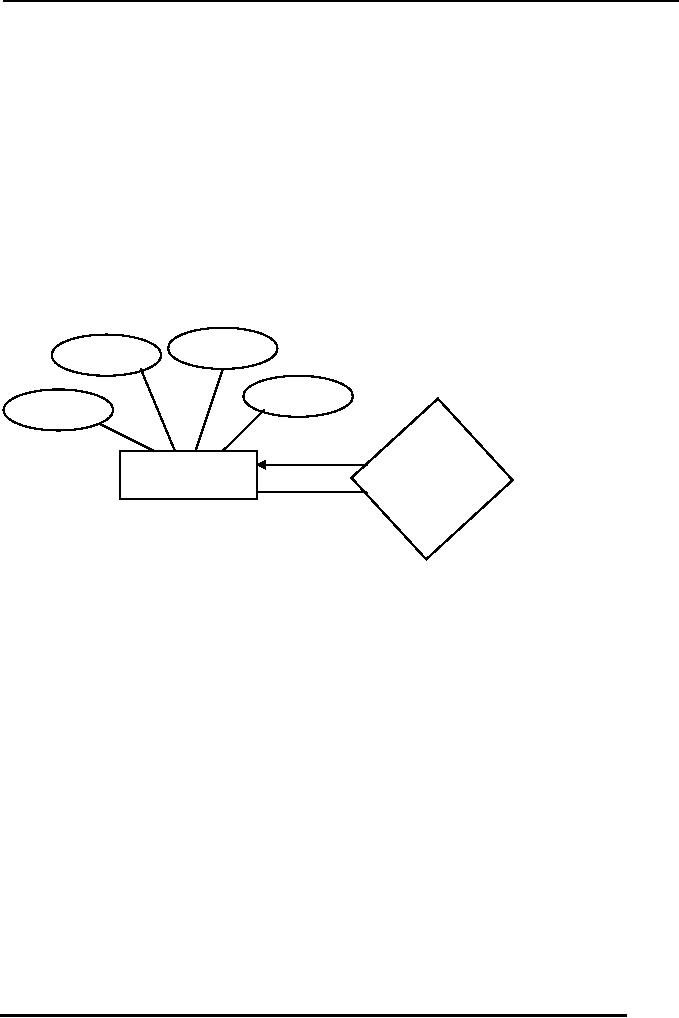
Database
Management System
(CS403)
VU
�
Entities
enrolled in a relationship are
called its participants.
The
participation of an entity in a
relationship is total
when
all entities of that set
might
be
participant in the relationship
otherwise it is partial
e.g. if
every Part
is
supplied by a
Supplier
then
the SUPP_PART relationship is
total. If certain parts are
available without
a
supplier than it is
partial.
Naming
Relationships:
If there
is no proper name of the association in
the system then
participants' names of
abbreviations
are used. STUDENT and CLASS
have ENROLL relationship.
However, it
can also be named as
STD_CLS.
Roles:
Entity
set of a relationship need
not be distinct. For
example
phone
name
city
SSN
manager
employee
works-for
worker
The
labels "manager" and "worker"
are called "roles". They
specify how employee
entities
interact via the "works-for"
relationship set. Roles are
indicated in ER diagrams
by
labeling the lines that
connect diamonds to rectangles.
Roles are optional. They
clarify
semantics of a
relationship.
Symbol
for Relationships:
�
Shown as
a Diamond
�
Diamond
is doubled if one of the participant is
dependent on the other
�
Participants
are connected by continuous
lines, labeled to indicate
cardinality.
�
In
partial relationships roles
(if identifiable) are
written on the line
connecting the
partially
participating entity rectangle to
the relationship
diamond.
�
Total
participation is indicated by double
lines
86
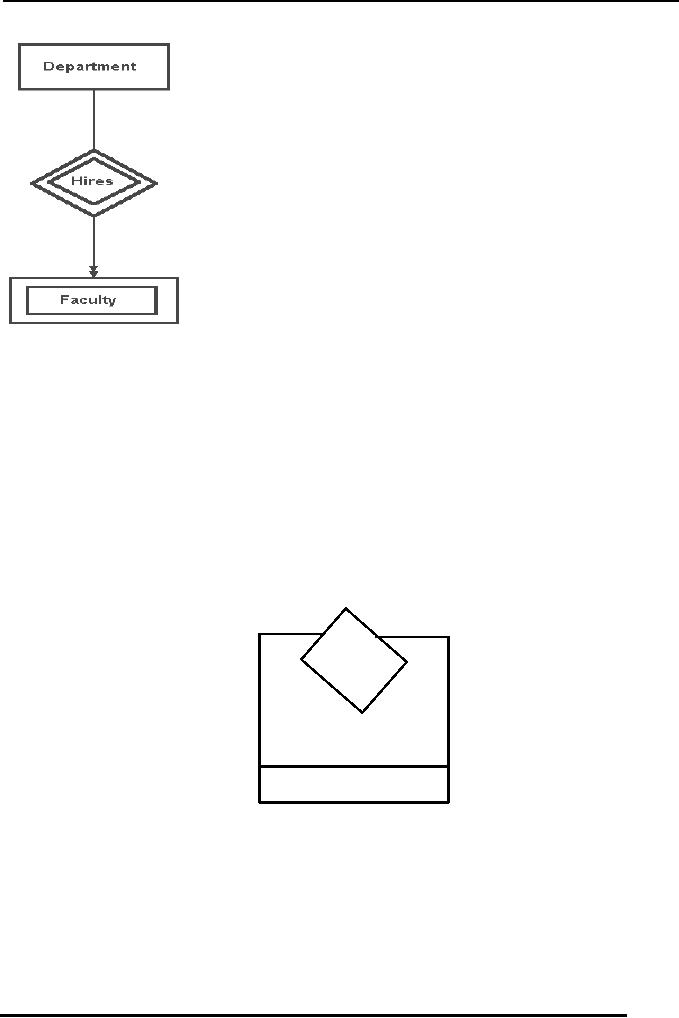
Database
Management System
(CS403)
VU
Types of
Relationships
o Unary
Relationship
An ENTITY
TYPE linked with itself,
also called recursive relationship.
Example
Roommate,
where STUDENT is linked with
STUDENT
Example
1:
Roommate
1:1
Student
87
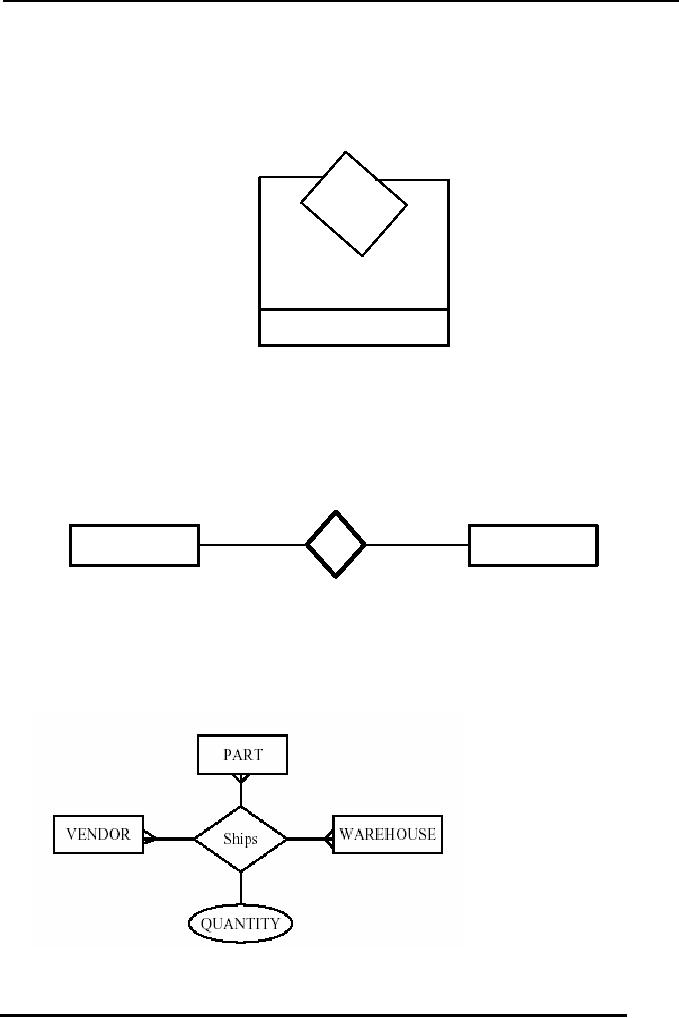
Database
Management System
(CS403)
VU
Example
2:
Sponsored
1:1
Person
o Binary
relationship
A Binary
relationship
is the one that links two
entities sets e.g. STUDENT-CLASS.
Relationships
can be formally described in an ordered
pair form.
Enroll =
{(S1001, ART103A), (S1020, CS201A),
(S1002, CSC201A)}
Entire
set is relationship set and
each ordered pair is an instance of
the relationship.
M:N
Student
Class
o Ternary
Relationship
A Ternary
relationship
is the one that involves
three entities e.g.
STUDENT-CLASS-FACULTY.
88
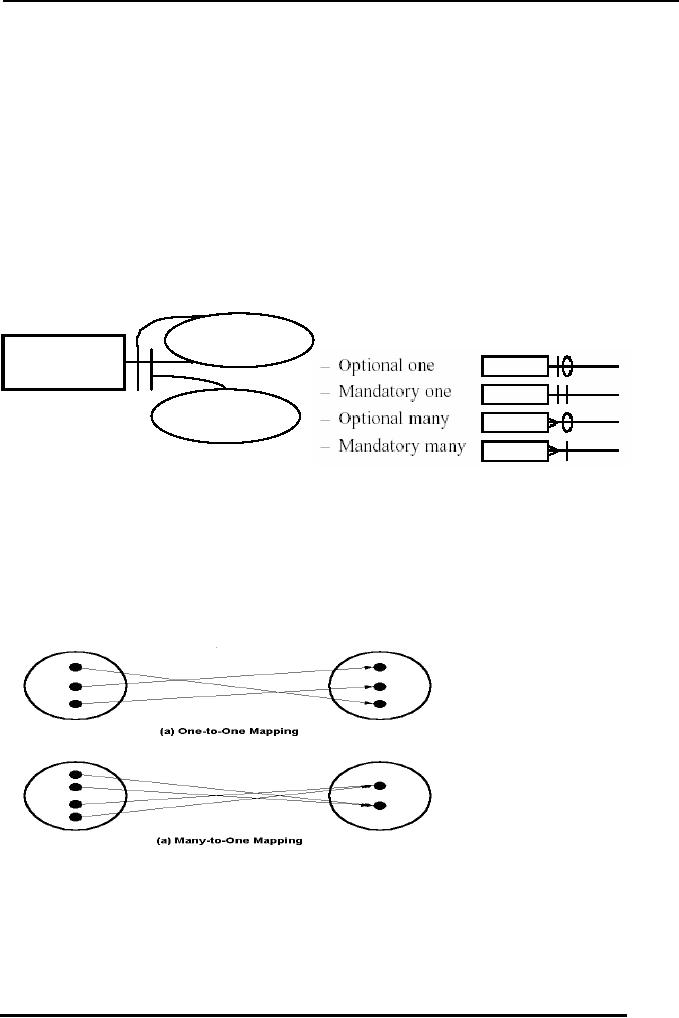
Database
Management System
(CS403)
VU
o N-ary
Relationship
Most
relationships in data model
are binary or at most
ternary but we could define
a
relationship
set linking any number of
entity sets i.e. n-ary
relationship
Entity
sets involved in a relationship
set need not be distinct.
E.g.
Roommate
= {(Student1, Student2) | Student1
∈
Student
Entity Set, Student2 ∈ Student
Entity
Set and Student 1 is the
Roommate of Student2}
Relationship
Cardinalities
The
cardinality of a relationship is the
number of entities to which
another entity can map
under
that relationship. Symbols
for maximum and minimum
cardinalities are:
Maximum
inside
Entity
Type
Minimum
Outside
o One-to-One
mapping:
A mapping
R from X to Y is one-to-one if each
entity in X is associated with at
most
one
entity in Y and vice versa.
o Many-to-One
mapping:
A mapping
R from X to Y is many-to-one if each
entity in X is associated with
at
most one
entity in Y but each entity
in Y is associated with many
entities in X.
89
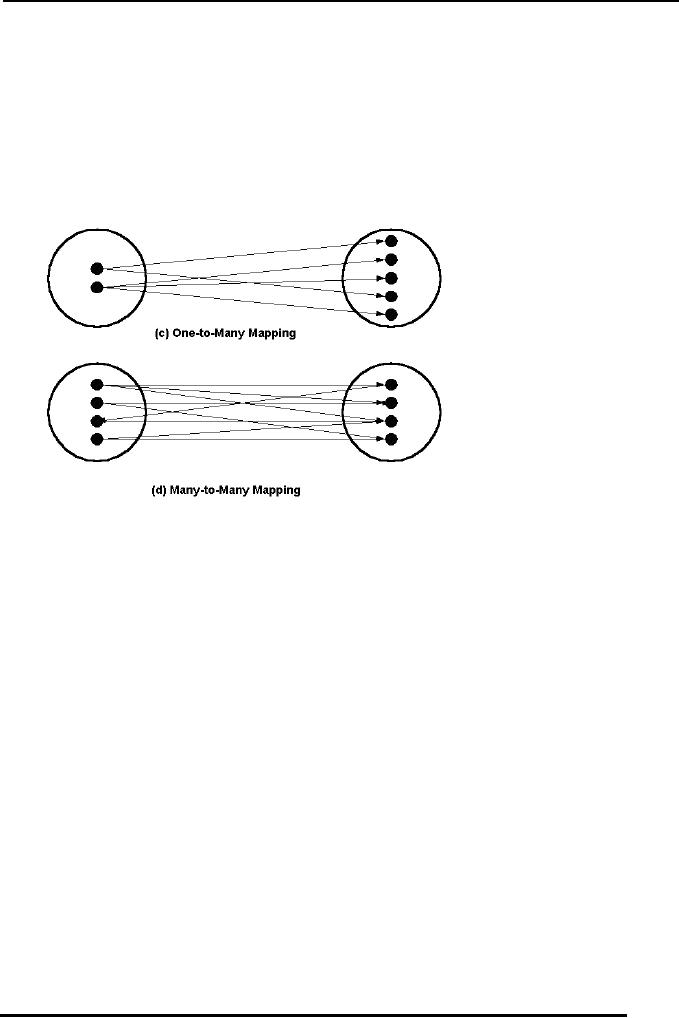
Database
Management System
(CS403)
VU
o One-to-Many
mapping:
A mapping
R from X to Y is one-to-many if each
entity in X is associated with
many
entities
in Y but each entity in Y is
associated with one entity in
X.
o Many-to-Many
mapping:
A mapping
R from X to Y is many-to-many if each
entity from X is associated
with
many
entities in Y and one entity in Y is
associated with many
entities in X.
90
Table of Contents:
- Introduction to Databases and Traditional File Processing Systems
- Advantages, Cost, Importance, Levels, Users of Database Systems
- Database Architecture: Level, Schema, Model, Conceptual or Logical View:
- Internal or Physical View of Schema, Data Independence, Funct ions of DBMS
- Database Development Process, Tools, Data Flow Diagrams, Types of DFD
- Data Flow Diagram, Data Dictionary, Database Design, Data Model
- Entity-Relationship Data Model, Classification of entity types, Attributes
- Attributes, The Keys
- Relationships:Types of Relationships in databases
- Dependencies, Enhancements in E-R Data Model. Super-type and Subtypes
- Inheritance Is, Super types and Subtypes, Constraints, Completeness Constraint, Disjointness Constraint, Subtype Discriminator
- Steps in the Study of system
- Conceptual, Logical Database Design, Relationships and Cardinalities in between Entities
- Relational Data Model, Mathematical Relations, Database Relations
- Database and Math Relations, Degree of a Relation
- Mapping Relationships, Binary, Unary Relationship, Data Manipulation Languages, Relational Algebra
- The Project Operator
- Types of Joins: Theta Join, Equi–Join, Natural Join, Outer Join, Semi Join
- Functional Dependency, Inference Rules, Normal Forms
- Second, Third Normal Form, Boyce - Codd Normal Form, Higher Normal Forms
- Normalization Summary, Example, Physical Database Design
- Physical Database Design: DESIGNING FIELDS, CODING AND COMPRESSION TECHNIQUES
- Physical Record and De-normalization, Partitioning
- Vertical Partitioning, Replication, MS SQL Server
- Rules of SQL Format, Data Types in SQL Server
- Categories of SQL Commands,
- Alter Table Statement
- Select Statement, Attribute Allias
- Data Manipulation Language
- ORDER BY Clause, Functions in SQL, GROUP BY Clause, HAVING Clause, Cartesian Product
- Inner Join, Outer Join, Semi Join, Self Join, Subquery,
- Application Programs, User Interface, Forms, Tips for User Friendly Interface
- Designing Input Form, Arranging Form, Adding Command Buttons
- Data Storage Concepts, Physical Storage Media, Memory Hierarchy
- File Organizations: Hashing Algorithm, Collision Handling
- Hashing, Hash Functions, Hashed Access Characteristics, Mapping functions, Open addressing
- Index Classification
- Ordered, Dense, Sparse, Multi-Level Indices, Clustered, Non-clustered Indexes
- Views, Data Independence, Security, Vertical and Horizontal Subset of a Table
- Materialized View, Simple Views, Complex View, Dynamic Views
- Updating Multiple Tables, Transaction Management
- Transactions and Schedules, Concurrent Execution, Serializability, Lock-Based Concurrency Control, Deadlocks
- Incremental Log with Deferred, Immediate Updates, Concurrency Control
- Serial Execution, Serializability, Locking, Inconsistent Analysis
- Locking Idea, DeadLock Handling, Deadlock Resolution, Timestamping rules